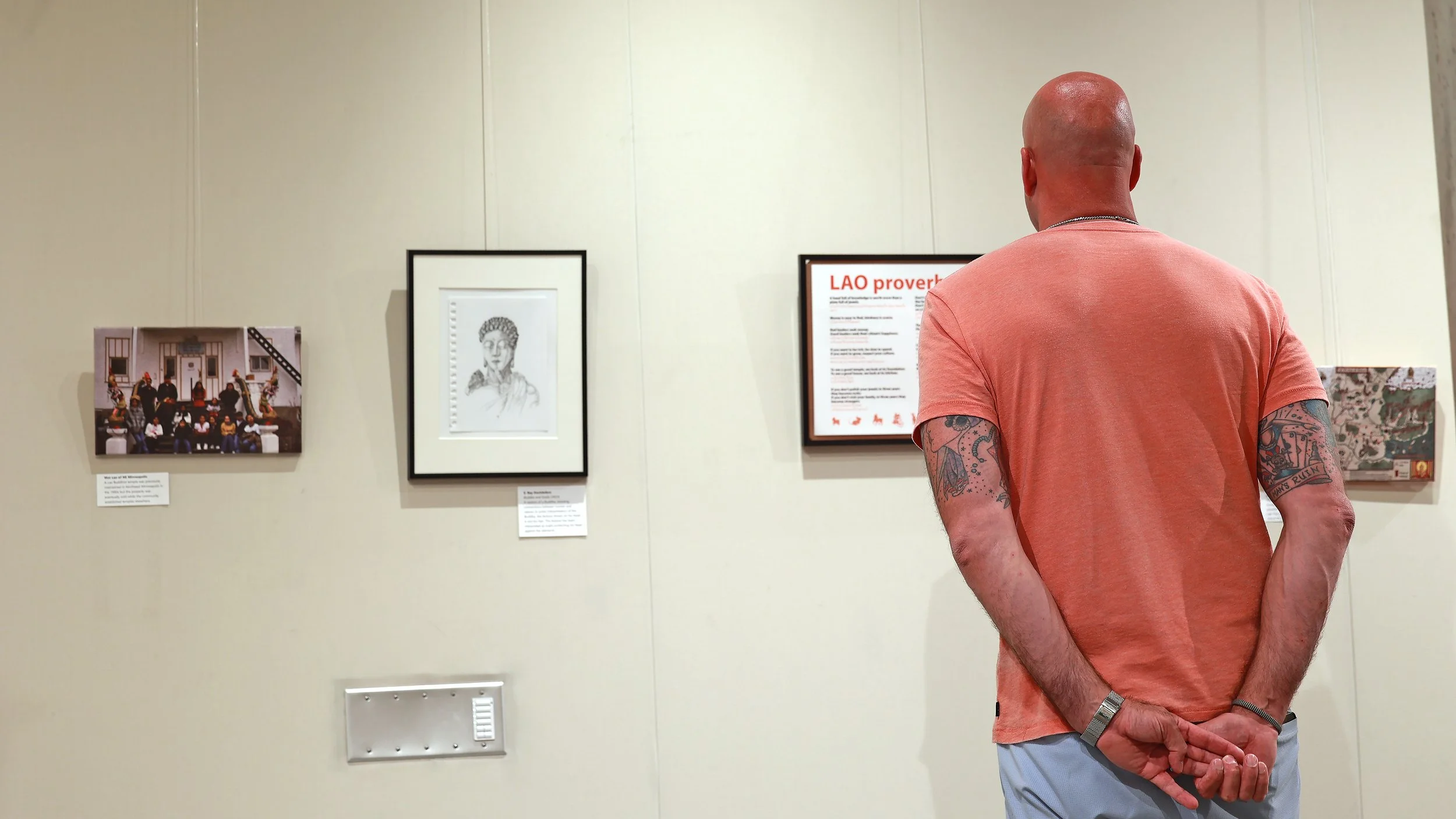After years of preparation, the Laomerica 50: Democracy and Diaspora exhibit has now opened at the Minneapolis Central Library at the Cargill Gallery as a joint project with the Lao Center of Minnesota and the SEALit Center to help the community reflect on the 50th anniversary of the Lao diaspora.
Gathered together are over 80 pieces reflecting 100+ years of Lao art, culture, and history. Many pieces being shown for the very first time in the public, while others are being recontextualized and reimagined.
This exhibit runs until September 27th on the 2nd floor in the Cargill Gallery, at 300 Nicollet Mall, Minneapolis, MN 55401 on most days starting at 9AM until 8PM (M-T) and 5PM (F-Su). This exhibit is free to the public and is suitable for families of all ages. You can see some of the images from the opening week here.
Laomerica 50: Democracy and Diaspora coincides with Lao American Artist Heritage Month. It is also a celebration of the 40th anniversary of the Lao Center of Minnesota, the 30th anniversary of the Paj Ntaub Voice Hmoob Literary Journal, 20 years of Legacies of War and 10 years of Sahtu Press, the first Lao American publishing company.

In the Lao language, democracy is ປະຊາທິປະໄຕ “Pa-xa Ti-pa-tai”. The idea of diaspora, or Lao living outside of Laos is often considered as ລາວນອກ “Lao Nawk” two ideas that are relatively new to the Lao people. “What have we done with our freedoms, our memories, and our imaginations in our first half century in America and other nations?” the organizers ask, even as many continue to challenge the contributions of immigrants and refugees.
2023-2025 marks the 50th anniversary since the end of the US Secret War in Laos and the transition from the Royal Lao Government to the Lao People’s Democratic Republic, and the start of a journey for many with roots in Laos around the world, including the US.
The question is particularly significant for the state of Minnesota, which has the third largest Laotian refugee population including ethnic Lao, Khmu, Tai Dam, Iu Mien and Hmong. Lao history with Minnesota can be said to have its start with Vice-President Hubert Humphrey’s historic visit to Laos in 1966. Our stories remain intertwined with Minnesota’s history in many unexpected ways.

For example, the United States dropped more bombs on Laos than on any other country in the 20th century. Over 30% of Laos remains contaminated with cluster bombs, many initially manufactured in Minnesota. Many fled to the United States because of their role in assisting the US during the Vietnam War, but few Americans know the full story, especially of veterans of the Royal Lao Army and the Special Guerrilla Units, or aviators such as the Ravens or Air America.
Minnesota inspired internationally recognized writers, artists, educators, entrepreneurs and community builders who’ve represented Laos and Minnesota at the Olympics, the Smithsonian, the National Endowment for the Arts, the Library of Congress and many other institutions.
But it is worth reminding ourselves that as a community, fewer than 14% successfully graduate college and fewer than 1% go on to a Master’s degree or higher. For decades, challenges persisted including anti-Asian racism, gang issues, deportations and rehabilitation, teen pregnancies, untreated PTSD and depression, substance abuse and gambling addictions, domestic violence concerns, police brutality, and gender equity issues. These issues were particularly challenging during the pandemic.
While Laos has often been described as a quiet peaceful Eden, much of its history is marked by turmoil and invasion, occupation and upheaval, and the exhibit shares copious examples of art and literature responding to that, and attempts to create a peaceful legacy.

Lao arts often searched for the best of their traditions, celebrating harmony and nature, the search for truth, wisdom and compassion, and the rejection of violence. Modern Lao American artists who generously contributed original artworks to this exhibit include Nor Sanavongsay, Malichansouk Kouanchao, Bounxou Daoheuang, Ladda Insixiengmay, Bay Koulabdara, Oura Sananikone, Tou Her, Sisavanh Phouthavong, Vongduane Manivong, Tony Innouvong, Loy Khambay-Correa, Kinnary Pimpadubsee, Chantala Kommanivanh, Timothy Singratsomboune, and Krysada Panusith Phounsiri. A special highlight is also being given to the work of chef Ann Ahmed, and companies such as Uprooted Coffee and Village Ghost.
Over the last 5 years the organizers and community stakeholders gathered archival photographs, visual art, short films, textiles, ephemera, rare books, and cultural objects that reflect the inner and outer lives of our community. The intent was to go beyond focusing on our memories, traditions and customs, but to share our various dreams and visions for our community in both Minnesota and across the globe.
We hope you’ll take the time to see this ground-breaking exhibit, one of the very first of its kind in an American library system.
Related events include:
-
Wednesday, August 7, 6-8 p.m. – Artist Reception at Minneapolis Central Library Doty Board Room
-
Saturday, August 10, Noon-3 p.m. – Artists in Focus: A community conversation and reflection with Lao artists Ladda Insixiengmay, Tou Her, and Bryan Thao Worra at Minneapolis Central Library Pohlad Hall
-
Saturday, September 14, 1-3 p.m. – Nakavi Lao Poet Convention at Minneapolis Central Library Pohlad Hall
-
Sunday, September 15, 1-4p.m. – Laomerica Film Festival at Minneapolis Central Library Pohlad Hall1-2 p.m. Lao American Short Films2-4 p.m. Origin Story: The Documentary
-
Friday, September 27, 3-5 p.m. – Closing Reception at Minneapolis Central Library Doty Board Room
Several of these programs are made possible through money from Minnesota’s Arts and Cultural Heritage Fund. These were made possible by the voters of Minnesota thanks to a legislative appropriation from the arts and cultural heritage fund.
